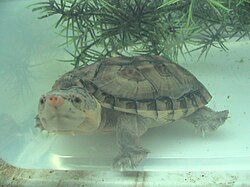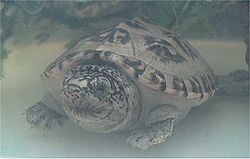This article needs additional citations for verification .(December 2018) |
| Staurotypus | |
|---|---|
 | |
| Staurotypus salvinii (Chiapas giant musk turtle or giant musk turtle) | |
| Scientific classification | |
| Domain: | Eukaryota |
| Kingdom: | Animalia |
| Phylum: | Chordata |
| Class: | Reptilia |
| Order: | Testudines |
| Suborder: | Cryptodira |
| Family: | Kinosternidae |
| Subfamily: | Staurotypinae |
| Genus: | Staurotypus Wagler, 1830 |
Staurotypus is a genus of aquatic turtles, commonly known as giant musk turtles, Mexican musk turtles, or three-keeled musk turtles, in the family Kinosternidae. The genus contains two recognized species, which are endemic to Mexico and Central America. Both species are sold and bred as pets.
